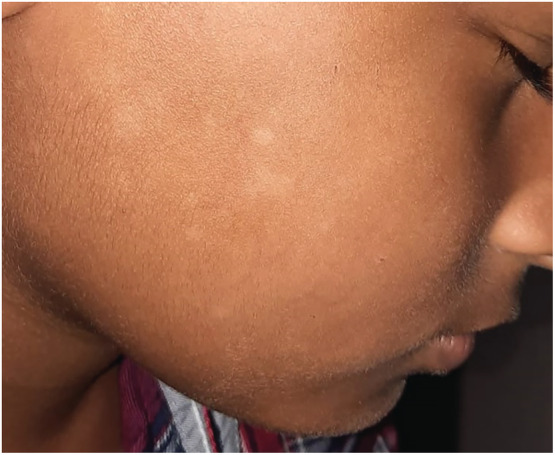Abstract
We describe a case series of seven children presenting with pityriasis versicolor on the face, localized to the area of coverage by the mask. The increased use of face masks after the opening up of schools, combined with a humid environment and associated sweating might be responsible for an increased presentation of facial pityriasis versicolor in children in our community.
Keywords: COVID‐19, mask, pityriasis versicolor
1. INTRODUCTION
The face is a site which is relatively less commonly affected by pityriasis versicolor. 1 Humidity and occlusion can trigger pityriasis versicolor. 2 Over a period of 6 months (October 2021 to March 2022) we saw an increased incidence of facial pityriasis versicolor in children. The period during which we saw our cases corresponds to the time when schools and day care centers in our community were reopened after being closed due to the COVID‐19 pandemic.
2. CASE SERIES
Seven children (5 male and 2 female) in the age group of 2–10 years presented with a history of 3–4 weeks duration of hypopigmented facial macules with fine scaling, primarily on the cheeks (Figure 1). Potassium hydroxide preparation was positive in all cases, showing the classical “spaghetti and meatball” appearance. In four patients, the face was the only site affected while in the other three lesions were present on the face and the trunk. In all cases, the facial lesions were restricted to the cheek area, specifically corresponding to the areas covered by the mask. All the patients had a history of primarily cloth mask usage, although the extent of usage differed, with the younger children wearing masks less frequently. All seven patients were treated with appropriate topical antifungals.
FIGURE 1.

Hypopigmented macules on right side of the face
3. DISCUSSION
The COVID‐19 pandemic and consequent mask usage have been associated with a variety of skin manifestations. Worsening or triggering of acne due to mask wearing has been commonly reported. The easing of lockdown measures has resulted in more children having to use masks, often for prolonged periods, for example, during school. Cloth masks are generally preferred for children in our community as they are readily available and have a snugger fit. It is possible that the occlusive effects of the mask, exacerbated by a humid environment, and aggravated by perspiration in physically active children, might produce a favorable environment for the proliferation of the fungus. Veraldi et al. reported an increased incidence and/or worsening of seborrheic dermatitis on the face in patients wearing facial masks for long durations. In these cases, the increased proliferation of Malassezia spp. under the high temperature and occlusion of the mask was proposed as a possible etiological factor. 3
In our series, the lesions on the face were specifically within the areas corresponding to the mask, with sparing of other sites like the forehead. It is also possible that the year‐round persistent humidity and high temperatures in our area may explain the higher incidence. Although we do not have specific supporting data, we have not observed a similar incidence of lower facial pityriasis versicolor prior to the pandemic.
CONFLICT OF INTEREST
The authors have no conflict of interest to declare.
ACKNOWLEDGMENTS
None.
Kaliyadan F, Ashique KT, Jayasree P. Increased incidence of facial pityriasis versicolor in children during the COVID‐19 pandemic—A consequence of mask usage? Pediatr Dermatol. 2022;1‐2. doi: 10.1111/pde.15043
DATA AVAILABILITY STATEMENT
The data that support the findings of this study are available from the corresponding author upon reasonable request.
REFERENCES
- 1. Varada S, Dabade T, Loo DS. Uncommon presentations of tinea versicolor. Dermatol Pract Concept. 2014;4(3):93‐96. [DOI] [PMC free article] [PubMed] [Google Scholar]
- 2. Park HJ, Lee YW, Choe YB, Ahn KJ. Skin characteristics in patients with pityriasis versicolor using non‐invasive method, MPA5. Ann Dermatol. 2012;24(4):444‐452. [DOI] [PMC free article] [PubMed] [Google Scholar]
- 3. Veraldi S, Angileri L, Barbareschi M. Seborrheic dermatitis and anti‐COVID‐19 masks. J Cosmet Dermatol. 2020;19(10):2464‐2465. [DOI] [PMC free article] [PubMed] [Google Scholar]
Associated Data
This section collects any data citations, data availability statements, or supplementary materials included in this article.
Data Availability Statement
The data that support the findings of this study are available from the corresponding author upon reasonable request.


